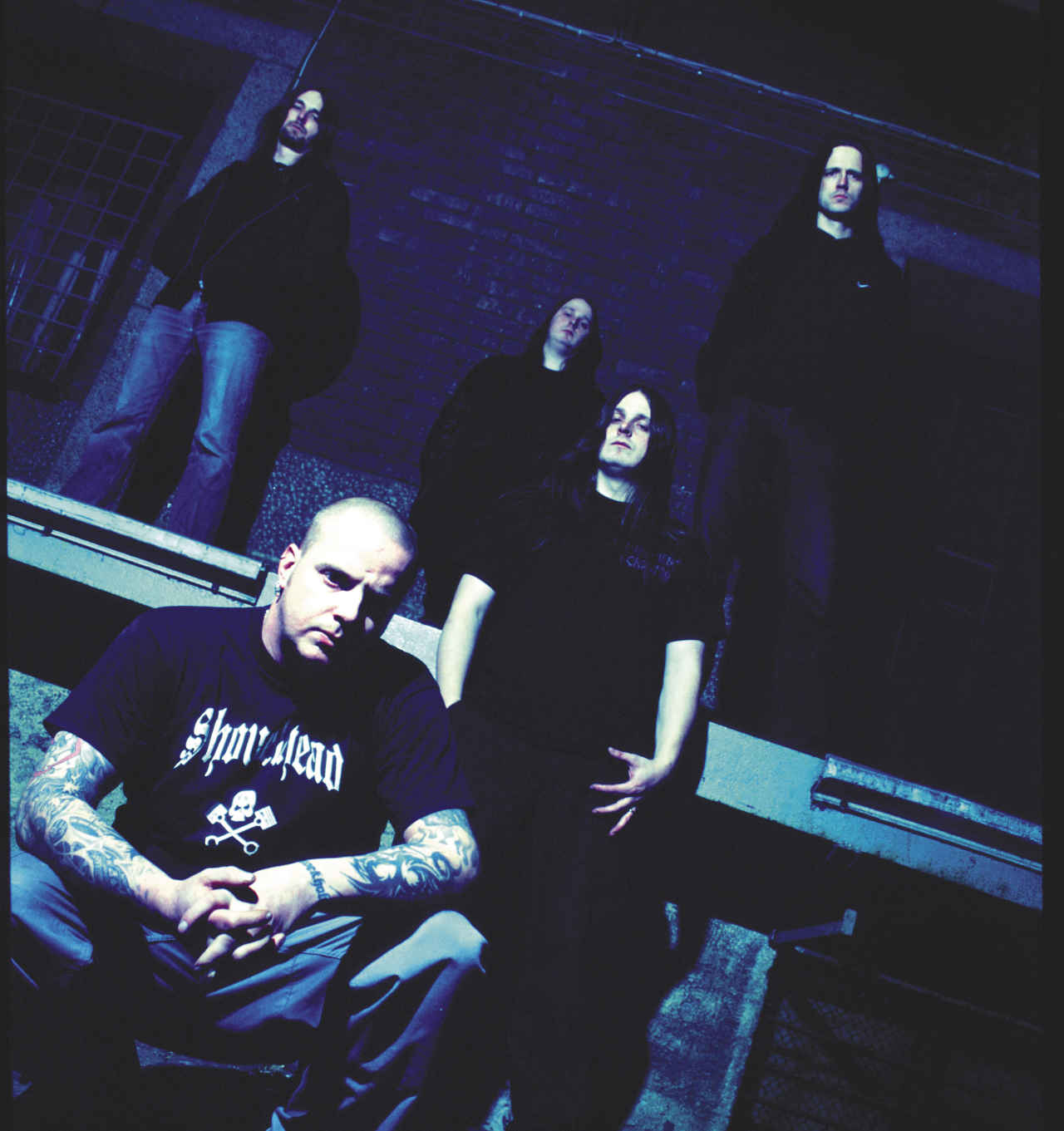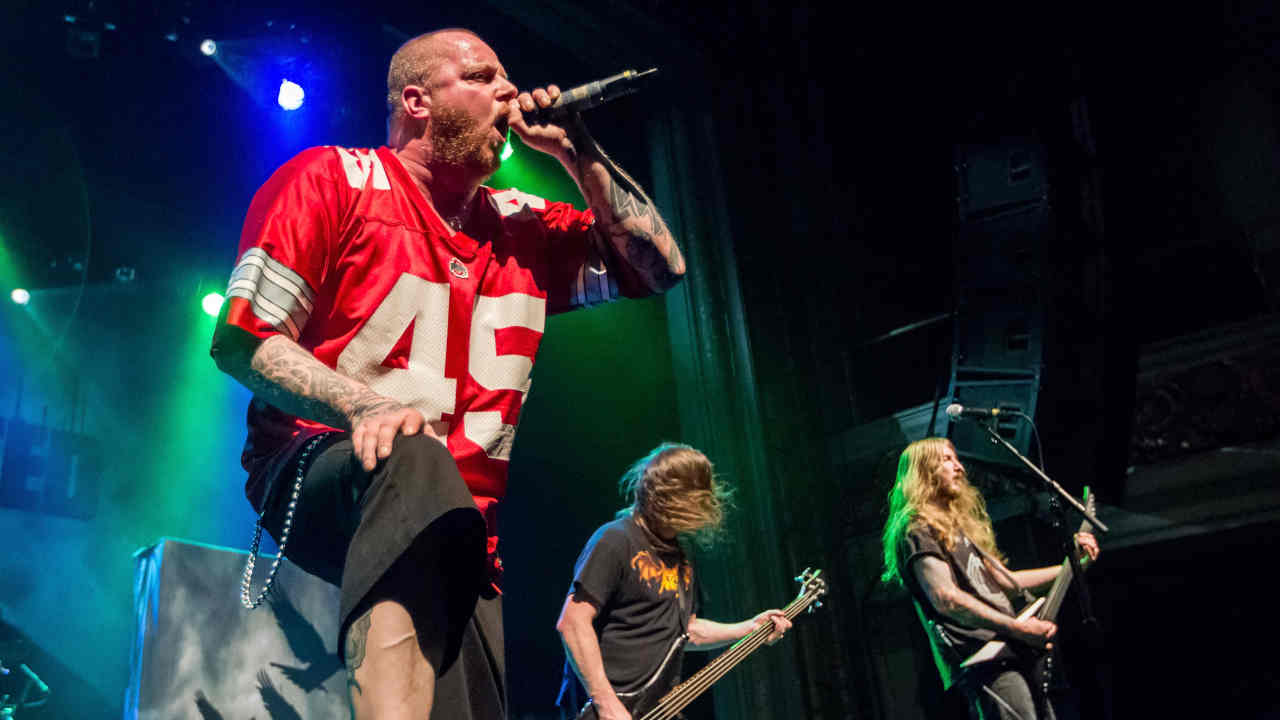“It was a dig at those people who did crazy, horrific things, and then tried to blame metal bands”: how The Haunted rose above the chaos to make a cult 21st century metal classic with Made Me Do It
The chaotic story of Swedish ragers The Haunted’s classic second album, Made Me Do It

Formed in Sweden in the late 1990s from the ashes of At The Gates, The Haunted bridged the worlds of 1990s melodeath and 80s thrash/hardcore. Their second album, 2000’s Made Me Do It, pushed them to the forefront of the Scandinavian metal scene. In 2007, guitarists Patrick Jensen and Anders Björler (who left The Haunted in 2012), talked Metal Hammer through the chaotic making of a 21st century classic.
At The Gates were one of the most influential death metal bands of the 1990s. Roaring out of Sweden at the very start of the decade, the four albums they released between 1992 and 1995 helped shaped what would become known as the Gothenburg Sound, influencing everyone from Trivium to The Black Dahlia Murder as well as countless metalcore outfits. But the intense workload they’d endured put pressure on the band members, and ATG split in 1996.
While singer Tomas Lindberg went on to front a host of bands, including Skitsystem, The Great Deceiver and The Crown, ex-At The Gates guitarist Anders Björler, his bassist brother Jonas Björler and drummer Adrian Erlandsson enlisted Witchery guitarist Patrick Jensen and vocalist Peter Dolving, formerly of acclaimed Swedish band Mary Beats Jane, and launched a new band, The Haunted.
Like At The Gates with more emphasis on 80s thrash and hardcore, The Haunted’s self-titled 1998 debut album – released via ATG’s former label Earache – saw the band the ground running. But the band soon ran into an obstacle, when Dolving quit to launch The Peter Dolving Band and explore spoken word performance. His replacement was Marco Aro, formerly of Swedish ragers Face Down. Aro was suggested by drummer Erlandsson.
“He remembered seeing Marco fronting Face Down, when they toured with At The Gates,” recalls Patrick Jenson. “Apparently, he introduced each song by hitting his head constantly with the microphone! That sounded right for us.”

Ironically, Erlandsson himself quit The Haunted soon afterwards to join Cradle Of Filth. He was replaced by Danish drummer Per Möller Jensen (no relation to guitarist Patrick Jensen).
“[Patrick] Jensen recommended Per Moller Jensen to us, as he played with him in Witchery,” says Anders Bjorler. “The problem was that he didn’t know we’d switched singers. He thought that Peter was still in the band. So, we sent Marco down to the airport to meet Per when he flew in from Denmark and explain the situation.”
Sign up below to get the latest from Metal Hammer, plus exclusive special offers, direct to your inbox!
After just one rehearsal, the new-look Haunted headed for the States, and a tour with Testament in August 1999.
“Our management called it a holiday for us, because we weren’t being paid,” says Björler with an ironic laugh. “But they weren’t with the band for too much longer anyway. Our managers believed that there was no future without Peter, so we parted.”
With Aro and Per Möller Jensen bedded in, The Haunted Mk 2 began work on their second album, Made Me Do It (aka, The Haunted Made Me Do It – geddit?). Just one problem: they hadn’t told Earache what they were up to.
“The deal we had with Earache Records for our debut was inherited from At The Gates,” reveals Björler. “That wasn’t fair on the rest of the guys. So, we did the second album without their knowledge.”
In theory, this meant the band were financing the recording sessions themselves. Given how little money they had, that could potentially have been a huge headache. Luckily, they received a stroke of good fortune.
“Berno Paulsson, who owned a studio in Malmö, really believed in us,” says Jensen. “He agreed to give the band the opportunity to do the new record while delaying payment until we’d got our deal sorted out.”
“He ended up co-producing the album with us,” says Björler “It was an odd time, though. We lived in the attic at Berno’s parents’ house. They were in their 80s. Imagine at that age trying to explain to your neighbours that you’ve got this metal band living in your house.”
Prior to going to Malmö, The Haunted had tried to get songs ready for the album at their own rehearsal studio in Gothenburg. Not that things went exactly to plan.
“We shared that studio with In Flames,” says Jensen. “They moved in with us. We spent ages trying to step over the guitars they left all over the place.”
“With Marco living in Stockholm and Per in Copenhagen, it was often just three of us in there,” says Björler. “We only ever had one rehearsal with Marco! There was also some pressure because we’d been booked in to record the album from January 2000, and that couldn’t be altered. In the end, we had no lyrics written, and not all the music was ready.”
Even after the band decamped to Malmö to record the album, there were yet more problems.
“Halfway through the recording sessions, Jensen and Per went out to tour with Witchery,” says Bjorler, still unimpressed at the memory. “By the time they left us for the road, we had no vocals recorded at all. Marco did the lot while they were away.”
“We had no clue what everything was going to sound like with the vocals,” recalls Jensen. “Per and I got back off tour [with Witchery], went into the studio and sat at the back with our arms folded. Then the tapes rolled, and we heard the songs for the first time with the vocals. I remember Marco looked really nervous playing it all to us.”
The pair recall Aro working quickly. “Marco did every vocal on the album in either one or two takes,” says Björler. “That’s the sort of person he was – if he couldn’t get something nailed quickly, then he’d give up.”
“I think Marco had a problem dealing with the fact that he’d replaced Peter,” says Jensen. “He spent too long trying to emulate what he’d done, rather than being himself, and he could get very impetuous and upset about things. He also only wrote lyrics for six songs on this album. It’s not that Marco couldn’t write – he’s talented enough – but he never could get himself motivated.”
Patrick Jensen and Per Möller Jensen’s parallel involvement with Witchery extended further than just going on tour with the latter. There was also an exchange of songs between the two bands. A song the guitarist had written for The Haunted’s debut album, A Paler Shade Of Death, had been co-opted by Witchery on their 1999 album Dead, Hot And Ready. This time around, the reverse happened.

“I came up with this riff for Witchery,” says Jensen. “But the rest of the band thought it would suit The Haunted better, so that became Dark Intentions [the opening song on The Haunted Made Me Do It].”
With the album completed, it was finally time to reveal to Earache what they’d been up to. “We took the record to Nottingham, where the company’s based,” says Björler, “and told them what we’d done without their input or knowledge. We offered to sign it to them. Fortunately they agreed to everything, and made no attempt to alter the record. We had full control.”
The two have different views of what would have happened if Earache had refused to re-sign the band. “We had other options,” says Björler. Jensen thinks differently “I don’t think we really did,” he counters. “If Earache had rejected the album, then I don’t know where we’d have ended up.”
Made Me Do It was released in September 2000. The title was the suggestion of band associate Andreas Pettersson, who had designed their logo.
“What we liked about it was that it was a dig at those people who did crazy, horrific things, and then tried to blame metal bands,” says Bjorler “All those lawsuits against Ozzy and Judas Priest. And that title seems to have taken on a life of its own since, with so many others borrowing from it.”
As vicious as their debut album but with a fresher sense of melody, Made Me Do It was well received by fans and critics alike, even winning a Swedish Grammy for Best Hard Rock Album. Yet any gains they’d made with the album were undone by an almost comical set of line-up.
First, Anders Björler left following 2001’s stop-gap live album Live Rounds In Tokyo, to be replaced by Marcus Sunesson of ex-At The Gates singer Tomas Lindberg’s band The Crown. The guitarist returned in time for 2003’s The Haunted’s third studio album, 2003’s One Kill Wonder, only for Marco Aro to depart shortly after that record was released. The singer’s replacement was none other than Peter Dolving, whose shoes Aro had stepped into two albums earlier.
The revolving door fun stopped for the rest of the decade, until Dolving quit the band for the second time following 2012’s Unseen album. He was followed out the door once more by Anders Björler and Per Möller Jensen, prompting remaining members Jonas Björler and Patrick Jensen to put the band on hiatus. When they returned for 2014’s it was without the former, whose place was taken by Ola England, and Dolving, whose place was taken by… Marco Aro, back for his own second tour of duty in The Haunted.
For all the line-up chaos and general struggles, The Haunted remain one of the linchpins of the 21st century Scandinavian metal scene, thanks in a large part to those first two albums.
“I think The Haunted Made Me Do It helped to define a particular sound,” says Anders Björler, who released a solo album in 2013 and currently plays with the reunited At The Gates. “Mind you, this wasn’t instant. It was only a few years later that you could hear our influence, when the American metalcore scene took off.”
“I think Anders and Jonas should be particularly proud of what they’ve achieved,” emphasises Jensen. “Not only are they on Slaughter Of The Soul by At The Gates, but the first two Haunted records as well. That’s three classics. Most people would be happy just to have been on one of them.”
Originally published in Metal Hammer issue 164. Updated in May 2024
Malcolm Dome had an illustrious and celebrated career which stretched back to working for Record Mirror magazine in the late 70s and Metal Fury in the early 80s before joining Kerrang! at its launch in 1981. His first book, Encyclopedia Metallica, published in 1981, may have been the inspiration for the name of a certain band formed that same year. Dome is also credited with inventing the term "thrash metal" while writing about the Anthrax song Metal Thrashing Mad in 1984. With the launch of Classic Rock magazine in 1998 he became involved with that title, sister magazine Metal Hammer, and was a contributor to Prog magazine since its inception in 2009. He died in 2021.

